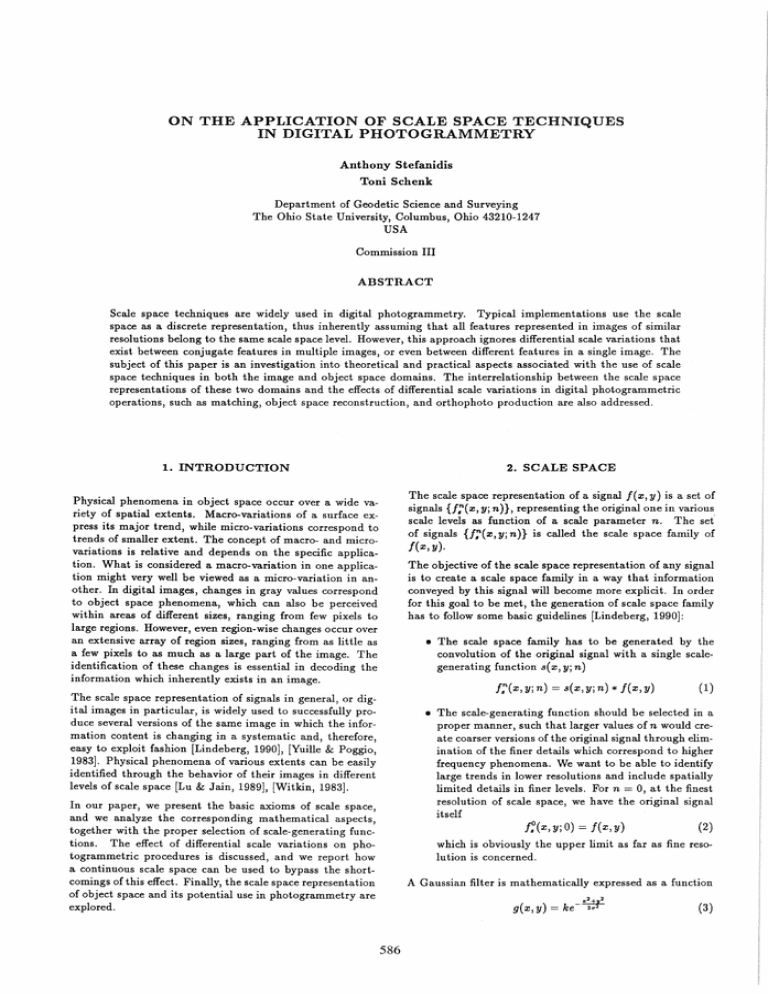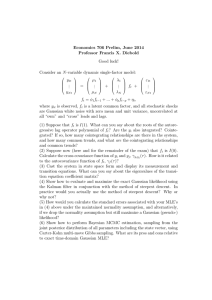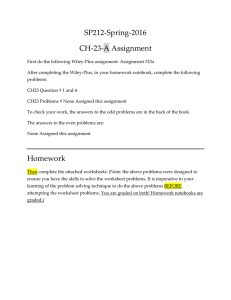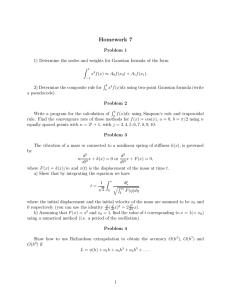ON THE APPLICATION OF SCALE SPACE TECHNIQUES
advertisement

ON THE APPLICATION OF SCALE SPACE TECHNIQUES
IN DIGITAL PHOTOGRAMMETRY
Anthony Stefanidis
Toni Schenk
Department of Geodetic Science and Surveying
The Ohio State University, Columbus, Ohio 43210-1247
USA
Commission III
ABSTRACT
Scale space techniques are widely used in digital photogrammetry. Typical implementations use the scale
space as a discrete representation, thus inherently assuming that all features represented in images of similar
resolutions belong to the same scale space level. However, this approach ignores differential scale variations that
exist between conjugate features in multiple images, or even between different features in a single image. The
subject of this paper is an investigation into theoretical and practical aspects associated with the use of scale
space techniques in both the image and object space domains. The interrelationship between the scale space
representations of these two domains and the effects of differential scale variations in digital photogrammetric
operations, such as matching, object space reconstruction, and orthophoto production are also addressed.
1. INTRODUCTION
2. SCALE SPACE
The scale space representation of a signal f( x, y) is a set of
signals {f:(:c, Yi n)}, representing the original one in various
scale levels as function of a scale parameter n. The set
of signals {f:( x, Yi n)} is called the scale space family of
Physical phenomena in object space occur over a wide variety of spatial extents. Macro-variations of a surface express its major trend, while micro-variations correspond to
trends of smaller extent. The concept of macro- and microvariations is relative and depends on the specific application. What is considered a macro-variation in one application might very well be viewed as a micro-variation in another. In digital images, changes in gray values correspond
to object space phenomena, which can also be perceived
within areas of different sizes, ranging from few pixels to
large regions. However, even region-wise changes occur over
an extensive array of region sizes, ranging from as little as
a few pixels to as much as a large part of the image. The
identification of these changes is essential in decoding the
information which inherently exists in an image.
f(x,y).
The objective of the scale space representation of any signal
is to create a scale space family in a way that information
conveyed by this signal will become more explicit. In order
for this goal to be met, the generation of scale space family
has to follow some basic guidelines [Lindeberg, 1990]:
.. The scale space family has to be generated by the
convolution of the original signal with a single scalegenerating function s( x, Yi n)
r:(x,Yjn) = s(x,Yjn) * f(x,y)
The scale space representation of signals in general, or digital images in particular, is widely used to successfully produce several versions of the same image in which the information content is changing in a systematic and, therefore,
easy to exploit fashion [Lindeberg, 1990], [Yuille & Poggio,
1983]. Physical phenomena of various extents can be easily
identified through the behavior of their images in different
levels of scale space [Lu & Jain, 1989], [Witkin, 1983].
(1)
.. The scale-generating function should be selected in a
proper manner, such that larger values of n would create coarser versions of the original signal through elimination of the finer details which correspond to higher
frequency phenomena. We want to be able to identify
large trends in lower resolutions and include spatially
limited details in finer levels. For n = 0, at the finest
resolution of scale space, we have the original signal
itself
In our paper, we present the basic axioms of scale space,
and we analyze the corresponding mathematical aspects,
together with the proper selection of scale-generating functions. The effect of differential scale variations on photogrammetric procedures is discussed, and we report how
a continuous scale space can be used to bypass the shortcomings of this effect. Finally, the scale space representation
of object space and its potential use in photogrammetry are
explored.
f~(x,YjO)
= f(x,y)
(2)
which is obviously the upper limit as far as fine resolution is concerned.
A Gaussian filter is mathematically expressed as a function
(3)
586
from the 2048 x 2048 pixel version to demonstrate the associated differences in resolution. Both images were obtained
by the convolution of the original 4096 x 4096 image with a
Gaussian kernel, and by proper resampling.
where 0" is the associated standard deviation. In applications, the multiplicative factor k may receive various values,
creating a large array of Gaussian filters which are essentially scaled variations of the core function, e.g.,
(4)
attempts to preserve the output within a prespecified range
[Agouris et al., 1989]. The use of a Gaussian filter, with
standard deviation 0" as the associated scale parameter, as
a scale-generating function satisfies the above set criteria
[Babaud et al., 1986]. Therefore, the scale space family of a
signal f (Z, y) can be created as
(5)
Figure 2: Two windows of equal size in pixels, one in 512 x
512 resolution (left) and the other in 2048 x 2048 resolution
(right ).
A digital image is a two-dimensional discrete signal J(z,y).
Its convolution with the Gaussian kernel
The use of a Gaussian kernel as a scale-generating function offers certain advantages, most notably exploited when
combining smoothing with edge detection. Edges are identified as discontinuities in the image function, and therefore
correspond to zero-crossings of the twice-differentiated image. The orientation independent second derivative of a
two-dimensional function is obtained through a Laplacian
operator
can be used to construct its scale space family. Members of
the scale space family may have the same dimensions as the
original image, or, more commonly, their dimensions may
decline in coarser resolutions. Assuming the original image
J(z, y) to have dimensions 4096 x 4096 pixels, we can form
its scale space family by creating m versions of the image (all
of dimensions 4096 x 4096 pixels), each one by convolving
J( z, y) with a Gaussian kernel of different scale parameter
(7)
The associative property of convolution allows the combination of scale space generation with a Gaussian function
G( Zg, yg) and differentiation with a Laplacian operator, thus
substituting two convolutions by a single one
0".
Instead of scaling the image with G(Zg, yg) and then looking
for edges in the smoothed image, we simultaneously smooth
the image and extract its orientation-independent second
derivative in a single convolution by the Laplacian of Gaussian (LoG) function
The size of the LoG operator is determined by the value of
or altenatively, by the diameter w of its positive central
region, which is related to 0" through the equation
0"
Figure 1: An image pyramid as a representation of discrete
scale space
w
However, in most applications coarser levels of scale space
are represented by images of smaller dimensions. By convolving the image with a Gaussian kernel and resampling
every nth pixel we can create a lower resolution copy of size
4096/nx4096/n. A scale space family in which lower resolution members are represented by smaller size images is called
an image pyramid [Fig. 1]. Various members of the image
pyramid can be perceived as images of the same object scene
in various geometric scales. For practical reasons the dimensions of the members of the scale space family are integer
powers of two. Typically, the image pyramid of an original
image of 4096 x 4096 pixels includes versions of the image in
dimensions of 2048 x 2048, 1024 x 1024 and 512 x 512 pixels.
Fig. 2 shows two windows of equal dimensions, one from the
512 X 512 pixel member of an image pyramid and the other
=
2y20"
(10)
Scale space family generation and edge detection can thus
be succesfully combined. By using the Gaussian kernel for
scaling we ensure that in any scale level fewer edges occur
than in finer resolutions and more than in coarser ones, thus
performing proper scale space generation. This property has
a qualitative aspect in addition to its obvious quantitative
meaning. Edges detected in coarser levels using large 0" (or
w) values will also appear in finer levels. The same edge can
be traced through various resolutions, since its images displaya certain degree of geometric similarity, with the degree
of localization (closeness to the true edge) increasing with
resolution [Lu & Jain, 1989], [Witkin, 1983]. This is demonstrated in Fig. 4 and Fig. 5 which show edges of the original
image (shown in Fig. 3) produced by its convolution with a
587
fine (w = 10) and a coarse (w = 30) LoG operator respectively. In addition, the traces of edges in various resolutions
offer a complete representation of the original signal, thus
allowing its reconstruction [Yuille & Poggio, 1983].
3. DIFFERENTIAL SCALE VARIATIONS
When representing the scale space family of a digital image
as a pyramid, we create a number of discrete representations
of the original image with each representation corresponding to a specific scale level. However, unless the imagegenerating projection is parallel, the exposure vertical and
the object surface planar, features within the same image
pyramid level will not have the same geometric scale, expressed as
(11)
Figure 3: The original image
with A' the image of a feature A of the object space. For
the projective transformation governing the image formation
process, the scale factor Si at a point (xi, yi) of the image,
corresponding to a point (Xi, yi, Zi) in the object space will
be given through the formula
(12)
where R is the rotation matrix and (Xo, Yo, Zo) the exposure
station coordinates of the photo. It is apparent that different
features in the same image will have different scale factors.
In addition, the images of the same object space feature in
two or more different images will have different scales, particularly when the exposure conditions (rotations, exposure
stations) differ significantly (e.g., converging photography)
or the object space surface displays high variations. In the
extreme case, the scale becomes 0 and occlusions occur.
Assuming each image pyramid level i to correspond to an
average scale Si, features within this image will thus appear
in scales
Figure 4: Edges detected with a fine LoG operator
(w = 10)
which in general will not coincide with any of the discrete
scales represented by the image pyramid. Image pyramids
though are discrete representations of the scale space which
itself is continuous. While the discrete representation is obtained using only a number of values of the scale parameter (1'
of the Gaussian kernel used to convolve the image, a continuous representation is the outcome of the same convolution
allowing (1' to receive any allowable real value.
Scale variations between members of stereopairs become apparent in digital photogrammetric operations, with matching serving as a good example. In least squares matching,
we attempt to match windows of pixels by minimizing their
radiometric differences. This is achieved by forming one observation equation for every pair of conjugate pixels within
a pair of approximately conjugate image windows 9L(XL, YL)
and 9R(XR, YR) in the left and right image respectively
Figure 5: Edges detected with a coarse LoG operator
(w = 30)
The solution is obtained by allowing one of the two windows
to be geometrically reshaped according to an affine transformation and by resampling gray values for this newly defined
588
window. Differences in scale are accommodated by the two
scale factors assumed in the six-parameter affine transformation
(15)
and
(16)
Updating the above affine transformation parameters by the
solution of the linearized observation equations
9L(XL,YL) - e(x,y)
9'R(x'R,Y'R) + 9R", da l + 9R.,XLda2
+ 9R",YL da 3 + 9R,db 1 + 9R y x Ldb2
+ 9R",yLdb 3
(17)
4. SCALE SPACE REPRESENTATION OF
OBJECT SPACE
we define a new window in the right image within which we
resample the gray values.
Object space can be described by the combination of two
two-dimensional continuous signals, one (Z(X, Y)) expressing its geometric and another (R(X, Y)) expressing its radiometric properties. Discretized, these signals are represented by a Digital Elevation Model and a Digital Radiometry Model which can be together referred to as DERM.
Scale variations will affect this procedure in various stages.
When two image patches are represented in two different
scale levels in a stereopair, their scale difference will be
both geometric and radiometric. When resampling the gray
values 9R(XR, YR) we use the original image, spreading or
shrinking its gray values over a new area, according to the
updated affine transformation parameters. As a result we
produce a new window in the right image which might belong to the same geometric level of scale space as its conjugate left image template 9L(XL, YL) but will still differ from
it in the radiometric scale space. This will have obvious effects on the observation equations, since we use gray level
differences as observations. The same problem occurs during digital image warping or rectification for orthophoto production [Doorn, 1991], [Novak, 1992]. Conjugate patches in
two overlapping orthophotos are brought to the same scale
level geometrically, using as a reference a digital elevation
model of the object space. Radiometrically though, these
patches remain unequal to the same degree that the corresponding windows in the original stereopair were unequal.
This causes conjugate patches in overlapping orthophotos to
differ radiometrically, even when their gray level histograms
are adjusted for average and standard deviation differences.
Each of the signals can be individually expressed in a scale
space representation using the Gaussian kernel, thus preserving the scale space family properties that we presented
in section 2. The scale space family of the DEM will consist
of DEM of lower resolutions, with each lower resolution level
representing a smoothed version of the original signal. Taking advantage of the self-reciprocity of the Gaussian function which states that the Fourier transform of a Gausian is
another Gaussian
F[G(x)] = G(w)
which would correspond to a matching process adapting itself into various scales. The above equation may be linearized with respect to x, Y and s, essentially adding to the
previously mentioned (eq. 17) linearized observation equations one term
+9R,dYR
In a similar fashion, the Digital Radiometry Model (DRM)
of the surface can be processed with a Gaussian filter for the
generation of its scale space family. Edges in the DRM will
correspond to positions where the radiometric properties of
the surface present discontinuities.
+ 9R.,dxR +
+ 9Rs ds R
(20)
we see that convolution with a Gaussian function in the
space domain is equivalent to a filtering with a filter of the
same shape in the frequency domain [Weaver, 1983]. Therefore, Gaussian convolution can be perceived as filtering with
a low-pass filter, the cut-off frequency of which is determined
by the scale parameter (J'. Coarse scale representations of
the D EM preserve the major geometric trends of the surface, corresponding to the lower frequencies of its frequency
domain equivalent. In finer resolutions, frequencies of higher
order are introduced. Edge detection, with the application
of an LoG function to the DEM signal, will locate breaklines [Chakreyavanich, 1991J. Breakline detection can be
applied hierarchically, similarly to edge detection in images.
In coarse levels of scale space (large w parameter) we detect
major breaklines in the topographic surface, while moving
to finer resolutions we not only improve the spatial accuracy
of these breaklines, but we also identify breaklines of smaller
spatial extent.
To accommodate for the problem of different scales, the scale
concept has to be introduced into the matching process itself. This will be conceptually performed by the alteration
of the observation equations to accommodate for scale as
9R( X'R,Y'R,s'R)
the term 9 R s in that they are highly localized and obviously
orientation dependent. Even in the case that high dependency exists, matching may be implemented in two distinct
sets, properly constraining some of the parameters to realistic estimated values. To assure succesful implementation,
matching has to be performed in the highest possible common resolution of the two conjugate patches. That will obviously be the resolution of the coarser patch, and therefore
the finer patch has to be transferred into another scale level
using a Gaussian filter.
(19)
The added term 9 R s expresses how gray levels change at a
point whenever the scale level of the window within which
this point is located changes within the continuous scale
space. The term s has conceptual meaning and may be substituted by the (J' of the Gaussian filter or any other quantity
sufficiently describing scale.
The recorded image gray values represent the DRM as altered due to the geometric properties of the object space.
In the scale space family of DRM there will exist a member
which most closely corresponds to the image depicting this
DRM. For a DERM with no geometric variations, the edges
detected in the image function would correspond to discontinuities in DRM. In realistic situations though, DEM is not
flat and the image edges reflect the combined effect of geometric and radiometric discontinuities. Taking advantage of
The introduction of a scale parameter in least squares matching may introduce linear dependency. The terms 9R., and
9Ry also express gray level gradients, but are different than
589
this we can distinguish edges created by geometric and radiometric discontinuities in the object space, by comparing
the scale space of the image to the scale spaces of the object
space.
[6) Lindeberg T. (1990) Scale-Space for Discrete Signals,
IEEE Transactions on Pattern Analysis and Machine
Intelligence, Vol. 12, No.3, pp. 234-254.
[7] Lu Y. & Jain R.C. (1989) Behavior of Edges in Scale
Space, IEEE Transactions on Pattern Analysis and Machine Intelligence, Vol. 11, No.4, pp. 337-356.
5. COMMENTS
[8] Novak K. (1992) Rectification of Digital Imagery, Photogrammetric Engineering & Remote Sensing, Vol. 58,
No.3, pp. 339-344.
Scale space can be used to represent two dimensional signals in various resolutions. This representation can thus be
used for images as well as for radiometric and/or geometric descriptions of the object space. It is structured and
explorable and it can offer valuable assistance in various
photogrammetric processes.
[9] Schenk A.F., Li J.C. & Toth C. (1991) Towards an
A utonomous System for Orienting Digital Stereopairs,
Photogrammetric Engineering & Remote Sensing, Vol.
57, No.8, pp. 1057-1064.
The concept of scale space provides the theoretical foundation for hierarchical implementation of digital photogrammetric tasks, allowing otherwise cumbersome and time consuming modules to be performed quickly and effectively. For
instance, automatic stereopair orientation can be performed
using digital image pyramids to effectively lead the results
to continuously improving accuracies [Schenk et al., 1991).
[10] Weaver J.H. (1983) Applications of Discrete and Continuous Fourier Analysis, John Wiley & Sons.
(11) Witkin A.P. (1983) Scale-Space Filtering, Proceedings
7th International Joint Conference on Artificial Intelligence, Karlsruhe, pp. 1019-1022.
However, besides implementing some modules in a hierarchical fashion, scale space theory can also be used to refine
the performance of well-established processes, such as least
squares matching and orthophoto production. By investigating the differential scale variations which exist between
conjugate features in different images, we can deduce a scaleadapting matching process aiming at the optimization of
least squares matching. In orthophoto production, we can
bring features to the same radiometric and geometric level
of scale space, thus eliminating discrepancies and improving
its overall performance.
[12) Yuille A.L. & Poggio T. (1983) Fingerprints Theorems
for Zero-Crossings, A.I. Memo 730, Artificial Intelligence Laboratory, Massachusetts Institute of Technology.
In general, the advantage of using scale space theory to represent the object space is twofold. Signals describing the
object space can be stored in a compact yet efficient way
by recording their discontinuities through scale spa'Ce and
in addition, image and object space can be directly compared and semantic information can be extracted from this
comparison.
References
[1) Agouris P., Schenk A.F. & Stefanidis A. (1989) ZeroCrossings for Edge Detection, Proceedings 1989 ASPRS
Fall Convention, Cleveland, pp. 91-99.
[2] Babaud J., Witkin A., Baudin M. & Duda R.O. (1986)
Uniqueness of the Gaussian Kernel for Scale-Space Filtering, IEEE Transactions on Pattern Analysis and Machine Intelligence, Vol. 8, No.1, pp. 26-33.
(3) Bergholm F. (1987) Edge Focusing, IEEE Transactions
on Pattern Analysis and Machine Intelligence, Vol. 9,
No.6, pp.726-741.
[4] Chakreyavanich U. (1991) Regular DEM Data Compression by Using Zero Crossings: The Automatic
Breakline Detection Method, Report No. 412, Dept. of
Geodetic Science, The Ohio State University.
[5) Doorn B.D. (1991) Multi-Scale Surface Reconstruction
in the Object Space, Report No. 413, Dept. of Geodetic
Science, The Ohio State University.
590





